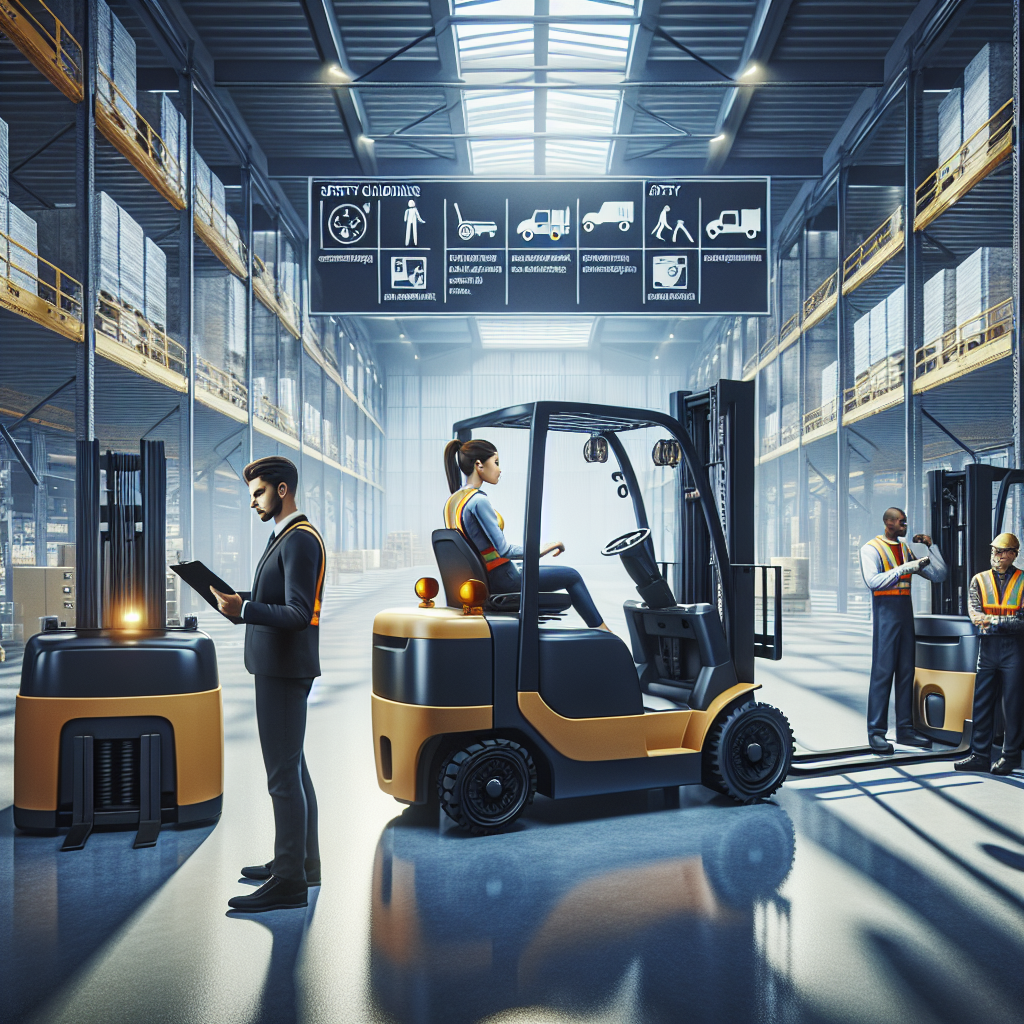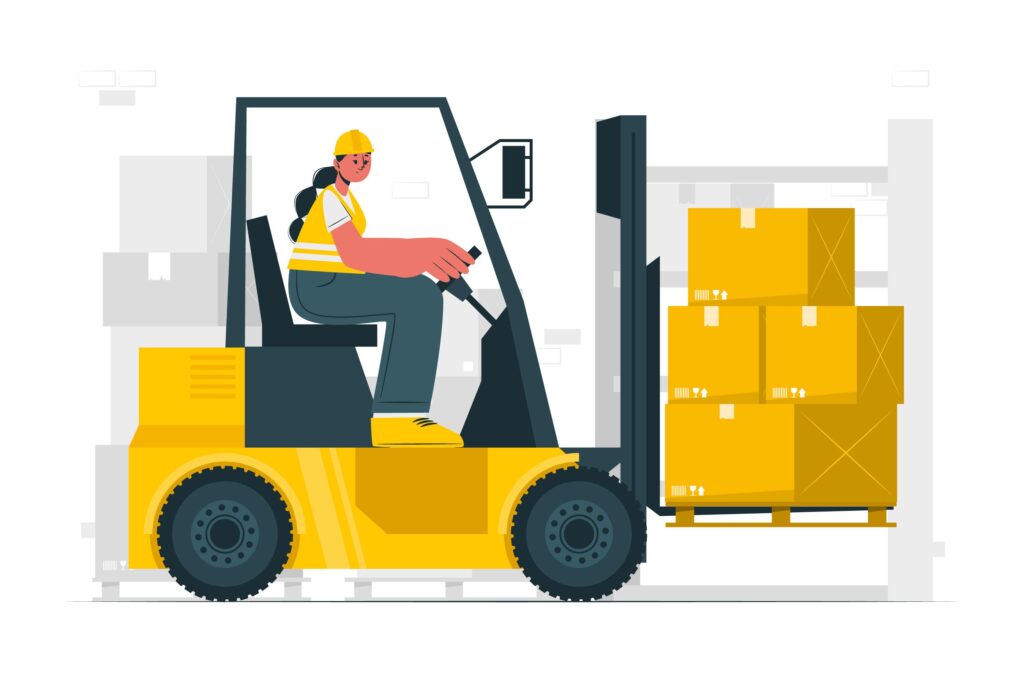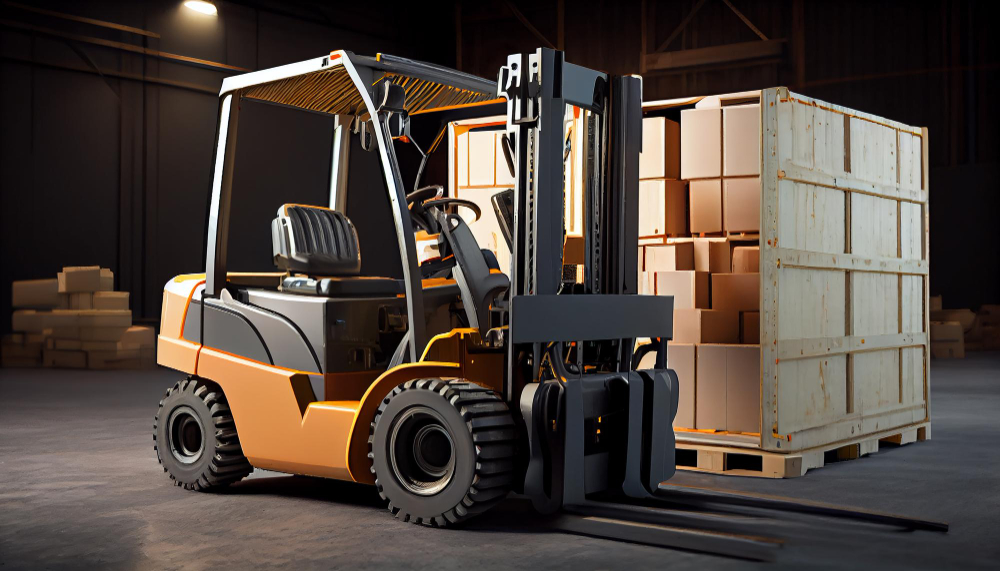Someone has to be qualified before running a forklift for a reason. These large, heavy machines are able to do a lot of harm or work. Products and supplies may be destroyed or damaged when run improperly, costing businesses additional time and money. Fortunately, there are strategies to either minimize or prevent forklift damage.
Forklifts are indispensable in modern warehouses, but they come with their own set of challenges. Forklift damage can lead to costly repairs, downtime, and even serious injuries. Knowing how to manage and prevent damage is crucial for maintaining a safe and efficient workspace. This blog post dives into practical steps you can take to reduce forklift damage, keeping both your equipment and your team safe.
Understanding Forklift Damage
It’s important to know the main forms of forklift damage and their causes before we go into preventive. Most often occurring forms of forklift damage include:
- Forklift collisions: These occur when a forklift crashes into an object or another vehicle.
- Overloading: When a forklift carries more weight than its capacity, it can lead to structural damage.
- Tip-overs: Forklifts are top-heavy vehicles, and they can tip over if not operated correctly.
- Wear and tear: Regular use of a forklift can cause wear and tear on its components, leading to breakdowns and malfunctions.
Knowing these typical kinds of harm helps you to be more proactive in avoiding them. Usually, a number of elements might cause harm; so, it is essential to solve every possible cause.
Common Types of Forklift Damage
Forklift damage can manifest in many ways, from minor scrapes and dents to significant structural issues. Common types include:
- Mast and Carriage Damage: Often caused by improper lifting techniques or overloading.
- Tire Wear and Tear: Resulting from uneven surfaces and poor maintenance.
- Hydraulic System Failures: Typically due to leaks or improper handling.
Although there are other possible causes of forklift damage, three prevalent forms of it are discussed here:
- Loads fly off the forks.
- The prongs pierce loads.
- The mast compresses pallets.
When forks misalign, cargoes are damp, pallets are placed wrongly, etc., these kinds of forklift damage results.
Financial and Operational Implications
Damaged forklifts can severely impact your bottom line. Here’s how:
- Repair Costs: Fixing damaged forklifts can be expensive, especially if the damage is extensive.
- Downtime: A forklift out of commission means slower operations, causing delays and inefficiencies.
- Safety Risks: Damaged forklifts can be hazardous, increasing the risk of accidents and injuries.
Steps to Reduce Forklift Damage
Proper Training and Certification for Operators
Ensuring your forklift operators are well-trained is the first step in reducing damage. Training should cover:
- Basic Operation Skills: Understanding how to operate the forklift safely and efficiently.
- Load Handling Techniques: Proper ways to lift, carry, and stack loads to avoid damage.
- Safety Protocols: Knowledge of safety measures to prevent accidents and equipment damage.
Regular Maintenance and Inspections
Routine maintenance is critical for keeping forklifts in good working order. Implement these practices:
- Scheduled Inspections: Regularly check all parts of the forklift for signs of wear and tear.
- Preventive Maintenance: Perform routine maintenance tasks like oil changes and tire rotations to prevent bigger issues.
- Record Keeping: Maintain detailed logs of all inspections and repairs for future reference.
Implementing Safety Guidelines and Best Practices
Creating and enforcing safety guidelines can drastically reduce the likelihood of forklift damage. Consider these strategies:
- Clear Pathways: Ensure that warehouse aisles are free of obstacles and clearly marked.
- Speed Limits: Implement speed restrictions for forklifts to reduce the risk of collisions.
- Communication Protocols: Establish a system for operators to communicate with each other and with pedestrians in the warehouse.
Investing in Advanced Technology for Forklifts and Warehouse Management
Leveraging technology can provide an extra layer of protection against forklift damage. Some options include:
- Telematics Systems: These systems monitor forklift usage and provide data on operator behavior, helping identify and correct risky practices.
- Anti-Collision Systems: Equip forklifts with sensors and alarms to prevent collisions.
- Automated Guided Vehicles (AGVs): Consider using AGVs for repetitive tasks, reducing the wear and tear on traditional forklifts.
How to Reduce the Damage Forklifts Cause
Errors do happen and human mistake is unavoidable. To assist lower forklift damage, nevertheless, warehouse managers and heavy equipment supervisors may follow certain guidelines.
Licensed Operators alone
As was already said, everyone operating a forklift must be certified and tested by a trained trainer, according to the Occupational Safety and Health Administration (OSHA). Forklift operators have to be recertified every three years to avoid OSHA penalties. When only trained staff members are using forklifts, you can help reduce the likelihood of damage coming from various pieces of material handling equipment. Lack of training behind the wheel of a forklift exposes workers not only for themselves and others but also for the products and surroundings they are working on.
See Your Pallets
Before pallet loading on a forklift, loads should be fully inspected for broken planks, jumping nails, or missing support blocks. If a load is stacked, wrapped, and loaded correctly, less probable is a forklift causing more damage when loading and hauling cargo.
Increase Lighting Additions
Industrial sites and warehouses are not uncommon for low or poor quality lighting. Changing the lighting in the forklift operation area helps to avoid errors in packing, picking, putaway, handling, and product transportation. Employees see better and feel better in clean, natural light as well.
Keep the aisles open.
Not built to swivel and overcome obstacles are forklifts. Warehouses should keep shelves clean of any rubbish or clutter in order to reduce forklift damage. Should a forklift have to handle an obstacle in an aisle or on the floor, it is more likely to cause their cargo to slip and collapse, or the forklift may run afoul of the shelves and pallets, harming the forklift, the load, and any other object nearby.
Evaluating the Impact of Forklift Damage Reduction Measures
Using techniques to reduce forklift damage not only helps preventive efforts but also directly improves the operational efficiency and safety culture of your warehouse. Reducing damage events helps businesses to greatly lower maintenance costs and downtime, thereby enabling better operations and higher production.
Encouragement of a safe workplace also improves worker morale and confidence as employees are guaranteed of their safety while carrying out their responsibilities. Improved performance and work satisfaction—two vital elements of any successful company—can follow from this as well. Regular audits and evaluations help to monitor the success of these policies so that the methods stay relevant and efficient in reducing harm over time.
Looking Ahead: Innovations in Forklift Safety
With continuous technological development, forklift safety seems to have a bright future. Emerging technologies, including sophisticated robots and machine learning algorithms, could improve warehouse operations even further. These technologies might help to identify maintenance requirements before problems start, automate difficult chores, and reduce human error.
Further protection may come from wearable technologies for operators, such as smart vests that track proximity to forklifts. Warehouses may keep leading edge in safety and efficiency improvements by keeping current with the most recent innovations and being receptive to include fresh ideas. Accepting these ideas will be essential to preserving high levels of safety and operational excellence as the sector develops.
How to Reduce the Risk of Damage From Forklifts
Effectively managing the risk of forklift damage requires a comprehensive approach that combines training, maintenance, technology, and safe practices. Here are several steps to help mitigate these risks:
Develop a Comprehensive Training Program
Make a significant training investment in every forklift operator. This should underline the need of safety and awareness in the workplace in addition to covering the fundamentals of running machines. The program should be routinely updated to include fresh safety procedures and to rejuvenate the memory of experienced operators, therefore guaranteeing that everyone is constantly ready to manage any dangers.
Establish a Routine Maintenance Schedule
Regular maintenance can mostly prevent equipment failure. Create a methodical maintenance calendar with daily inspections, regular diagnostics, and quick fix of any found problems. Maintaining all forklifts in good condition greatly reduces mechanical breakdown risk, therefore reducing accidents and extending equipment lifetime.
Foster a Safety-First Culture
Create a workplace where safety comes first even if everything else is important. Invite every staff member—not just operators—to see any dangers and quickly report them. Encouragement of a team-oriented attitude to safety will help to build a society wherein everyone feels accountable for preserving a safe surroundings.
Integrate Cutting-Edge Technology
Utilize technological advancements to your advantage. Install telematics and collision avoidance systems on forklifts to track movements and alert operators of potential dangers. Consider automating routine processes with robotic systems or implementing warehouse management software that ensures the efficient flow of logistics without unnecessary strain on forklifts.
Conduct Regular Risk Assessments
Perform frequent risk assessments to identify and address new potential hazards. By continuously evaluating the environment and processes, you can adapt and refine your strategies, keeping risks to a minimum. These assessments should be comprehensive, considering both equipment and personnel factors, to provide a holistic overview of safety conditions.
By following these steps, organizations can significantly reduce the risk of forklift-related damage, ensuring a productive and safe workplace. Prioritizing prevention and staying vigilant is key to mitigating potential risks and protecting both employees and assets from unnecessary harm.
Avoid letting forklifts cause expensive damage.
OSHA claims that 11% of forklifts used in America are involved in accidents annually and cause around 100,000 major or minor injuries. Serious OSHA fines and penalties, as well as loss to your inventory, damage to your material handling equipment, and worker injuries might all follow from forklift damage.
If you want forklift safety advice or are looking for excellent used forklifts to help boost output and efficiency in your warehouse, get in touch with American Forklifts.
Conclusion
Forklift damage is not just a costly inconvenience; it’s a safety hazard that can affect the entire warehouse operation. By taking proactive measures such as proper training, regular maintenance, and investing in advanced technology, you can significantly reduce forklift damage. Implementing these strategies will not only improve safety but also enhance overall warehouse efficiency.
For more insights and personalized advice on how to optimize your warehouse operations, consider booking a consultation with our experts. Together, we can create a safer, more efficient work environment for your team.



